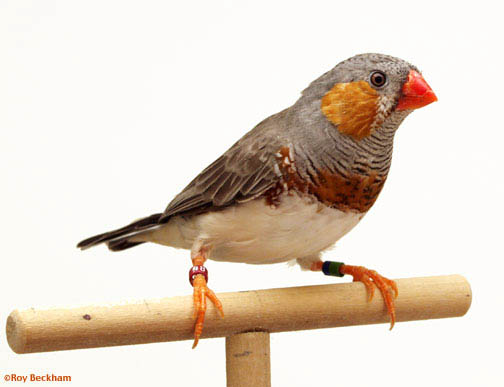




 |
|
|||||||||||||||||||||
 |
|
|
|
|
|
|
|
|
|
|||||||||||||
|
|
|
|
|
|
||||||||||||||||||
|
|
|
|
|
|
|
|
|
|
||||||||||||||
|
|
|
|
|
|
||||||||||||||||||
|
|
|
|
|
|
|
|
|
|
||||||||||||||
|
|
|
|
|
|
||||||||||||||||||
|
|
|
|
|
|
|
 |
|
|||||||||||||||
 |
 |
|
||||||||||||||||||||
|
|
|
|
||||||||||||||||||||
|
|
|
|
|
|
|
|
|
|
|
|
|
|
|
|
|
|
|
|
|
|
|
|
| Orange Breasted Zebra Finch | ||||
 |
||||
| Orange Breasted male | ||||
|
Mutation Effects Male: The Orange Breasted mutation works to change the black markings to orange. The breast bar, throat stripes, tear mark and tail bars will change to orange. With the tear mark changed to orange, it will appear as though the mark is missing next to the cheek patch. Female: The tear mark and tail bars should change to orange. The tear mark can be difficult to spot and may appear to be missing. Fledgling: Young OBs can often be identified by the lack of tear marks and orange in the tail bars. They will resemble female OBs. Identifying Splits Female: Like males, females may be some orange in the tail bars and the tear mark may be reduced.
Combinations Quite often, the Orange Breasted mutation is combined with the Fawn mutation. This is due to one of the difficulties of obtaining pure orange in the breast region of Gray birds. The Fawn males have dark brown markings and any traces that remain are more easily covered by the orange. It is also an attractive combination. The OB has also been combined with Chestnut Flanked Whites, Lightbacks and Dominant Silvers. These mutations tend to dilute the orange markings to varying degrees and as a result, the orange in the breast is also reduced. OB can be combined with Fawn Cheek birds and it has been reported that it is expressed in the single factor or split condition. I have not seen any of these FC OB combinations, but I wonder if the orange would be replaced by fawn which is one of the functions of the FC mutation. Orange Breast can also be combined with the Penguin mutation to produce an orange breast on its white belly. Since the Penguin mutation suppresses the black on the lower portion of the bird, the normal breast bar is not shown, but an orange breast can be produced. While it is interesting and helps with the understanding of how the Penguin mutation works, I think it detracts from a 'pattern' mutation like the Penguin. The Orange Breasted mutation does not seem to work with the Black Cheek mutation. These two mutations are in conflict. The BC mutation is working to change the orange areas to black and the Orange Breasted mutation is working to do the opposite. It is unknown what the combination looks like or if they can be combined. Orange Breasted Lightback (click to view)
Notes One of the difficulties with the Orange Breast mutation is to produce a completely orange breast that is devoid of any black marks. This is especially true of Gray zebras. Strong selection is the only solution that I'm aware of to reduce and eliminate the black in the breast. Many breeders will use Fawn birds since the effect is minimized with the fawn color. Also, when combined with the dilute varieties like Florida Fancy, CFW, Lightback and Dominant Silver, even in the gray series, the effect is minimized, but not necessarily eliminated. Some hens will begin to show male markings with the increased orange. The females will often show 'phantom' flanking that is similar to a male's flank marking or even cheek patches. It is often difficult to avoid in good specimens, but these should be considered faults. However, these may be the better stock birds to produce the most orange on males. |

Orange Breasted Black Breasted Fawn males
